The Battle of the P67 Boards - ASUS vs. Gigabyte at $190
by Ian Cutress on January 20, 2011 4:15 PM EST- Posted in
- Motherboards
- Gigabyte
- Asus
- P67
USB Speed
For this benchmark, we run CrystalDiskMark to determine the ideal sequential read and write speeds for the USB port using our 64GB Patriot SuperSpeed USB 3.0 drive. Then we transfer a set size of files from the SSD to the USB drive, and monitor the time taken to transfer. The files transferred are a 1.52 GB set of 2867 files across 320 folders – 95% of these files are small typical website files, and the rest (90% of the size) are the videos used in the Sorenson Squeeze test.
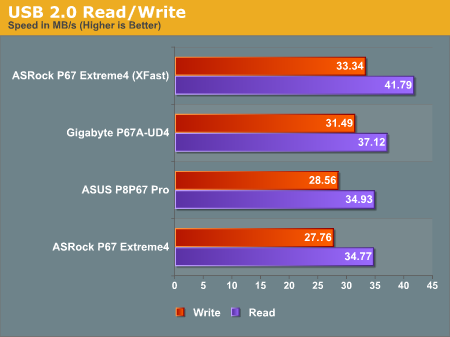
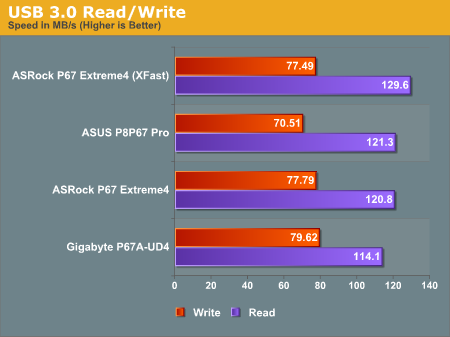
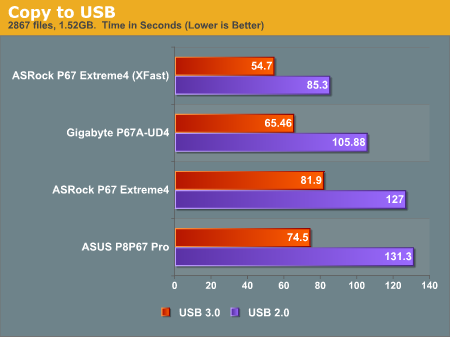
The Gigabyte board overall has the better USB performance, especially in USB 3.0 read speeds. This is accurately translated by the difference in copy time difference between the ASUS and Gigabyte boards in both USB 2.0 and USB 3.0.
3D Movement Algorithm Test
The first benchmark ran is actually one I have written. My full time job involves computational chemistry, so this first benchmark uses various algorithms for three-dimensional simulation and movement of independent particles. The algorithms both employ uniform random number generation or normal distribution random number generation, and vary in various amounts of trigonometric operations, conditional statements, generation and rejection, fused operations, etc. The benchmark runs through six algorithms for a specified number of particles and steps, and calculates the speed of each algorithm, then sums them all for a final score. This is an example of a real world situation that a computational scientist may find themselves in, rather than a pure synthetic benchmark. The benchmark is also parallel between particles simulated, and we test the single thread performance as well as the multi-threaded performance.

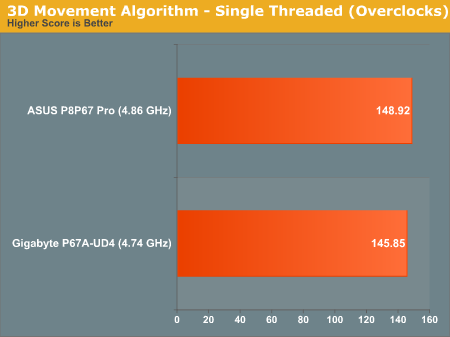
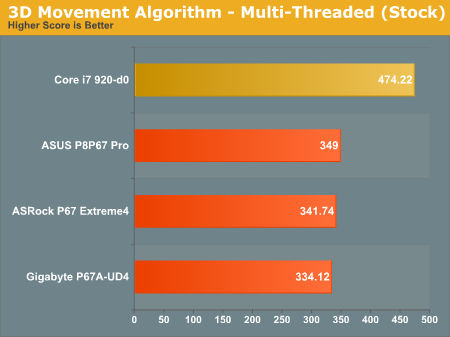
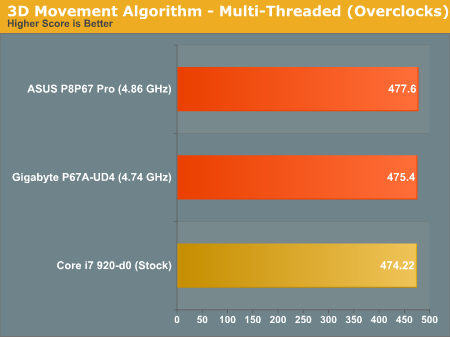
There's barely anything between the boards. The Core i7-920 pulls ahead at stock as it has 8 threads to tackle the workload, whereas the i5-2500K used in the P67 motherboards only has four.
WinRAR x64 3.93
With 64-bit WinRAR, we compress the set of files used in the USB speed tests. WinRAR x64 3.93 attempts to use multithreading when possible.
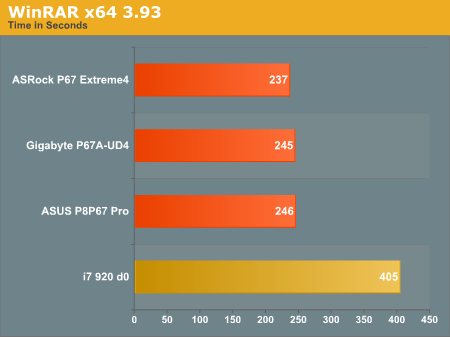
FastStone Image Viewer 4.2
FastStone Image Viewer is a free piece of software I have been using for quite a few years now. It allows quick viewing of flat images, as well as resizing, changing color depth, adding simple text or simple filters. It also has a bulk image conversion tool, which we use here. The software currently operates only in single-thread mode, which should change in later versions of the software. For this test, we convert a series of 170 files, of various resolutions, dimensions and types (of a total size of 163MB), all to the .gif format of 640x480 dimensions.
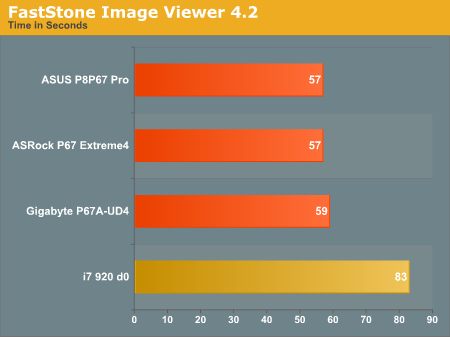
Sorenson Squeeze 6.0
Sorenson Squeeze is a professional video encoder, complete with a vast array of options. For this test, we convert 32 HD videos, each a minute long and approximately 42 MB in size, to WMV 512KBps format. Squeeze can encode multiple videos at once, one for each thread.
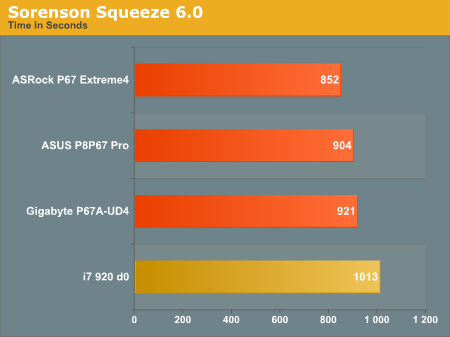
Conclusions
There is not much in it, but the ASUS board performs better in most benchmarks with one exception - the USB speed (especially the USB 3.0 read) is a step behind the Gigabyte.










137 Comments
View All Comments
Hogan773 - Friday, January 21, 2011 - link
No - its 42 dollars more for the Extreme 6 vs Extreme 4.If it were 10 bucks like you said, I'd get the 6. But not for 40 bucks.
cjs150 - Friday, January 21, 2011 - link
to full fat ATX boards anymore?With all the features being crammed in surely 99% of all users were find their needs met with a decent micro-atx board - heck probably 60%+ would be fine with a mini-ITX board.
Seriously do we really need 3 graphics card slots, 2 way SLI/Crossfire is overkill for the vast majority of people.
As on board sound gets better and better most people have given up on a sound card.
The most slots I have populated over the last 5 years is 5 (2 graphics cards, sound card, TV tuner and RAID card) and that was truly the exception. These days all I need is 3 cards for 2 way SLI and a TV tuner
strikeback03 - Friday, January 21, 2011 - link
Would also help if PCI disappeared so there was no question over what slots were included/available with certain cards. For example, the uATX board in my HTPC has 1 PCIe X1, 1 PCIe X16, and 2 PCI, which meant I had to get a PCI wireless card and if I wanted to add any additional tuners would have to get PCI for that as well, would have preferred more/all PCIe.Also, the spot in my desk for a tower isn't getting any smaller, no reason to not use a full-size ATX board with that much space.
7Enigma - Tuesday, January 25, 2011 - link
Yup. I have the space for a mid/full tower below my desk. It does no good for me to have a m-atx (actually it'd make it worse since it would be lower for the optical drive!). I also hate playing the cram game when trying to build and work on systems that are in such tight confines.Sure for people with very limited space or HT setups it's nice to have a smaller form factor, but a LOT (the majority?) of desktop users have a similar setup where space is rarely a real issue and the extra real-estate for cable management, component selection/replacement, and airflow/noise is a much greater factor.
seamusmc - Friday, January 21, 2011 - link
Gigabyte's and ASUS' offerings at the $150 price point. The main difference between ASUS' Pro and Non-Pro are SLI support and the Intel Nic.Personally I'd love to see a review of cheaper boards. Would it significantly reduce price if they didn't include on-board audio?
The main reason I'm considering the Pro is the Intel Nic, though I'm not sure if its really a big deal.
Another reason I am considering ASUS is that Gary Key and his staff are on the Xtreme and HardOCP forums addressing issues folks are encountering, providing OC guides and updated BIOS not available from the official site.
Not saying that there are no issues with the ASUS line, there are, but it seems many problems with the ASUS line are corrected by a) Using 1.5v memory; b) Fresh install of Win7; c) Over-clocking correctly, some folks are trying things that don't apply to SandyBridge.
Arbie - Friday, January 21, 2011 - link
We are six pages into the discussion with no signs of an idiotic flame war! This must be a recent record for Anandtech. Whatever the reason, it's certainly refreshing.7Enigma - Tuesday, January 25, 2011 - link
Trolls are still sleeping. And since it's not the normal FW companies (Intel vs. AMD, Nvidia vs. ATI).jfelano - Friday, January 21, 2011 - link
I don't understand the point of testing just TWO boards at a $190 price point. Makes no sense.DanNeely - Friday, January 21, 2011 - link
Maybe only Asus and Gigabyte gave $190 boards to review...LoneWolf15 - Friday, January 21, 2011 - link
While this may not be worth it to many, note that the ASUS board has an Intel gig NIC, and the Asrock has a Realtek.This also means (for what it's worth) that the ASUS board supports Intel VPro, while the Asrock does not. For many people, that isn't a factor --but it is worth knowing.
Just looked at that Asrock board --I think it's the first I've seen by them that I found really impressive on paper. I might have to read some reviews on it.